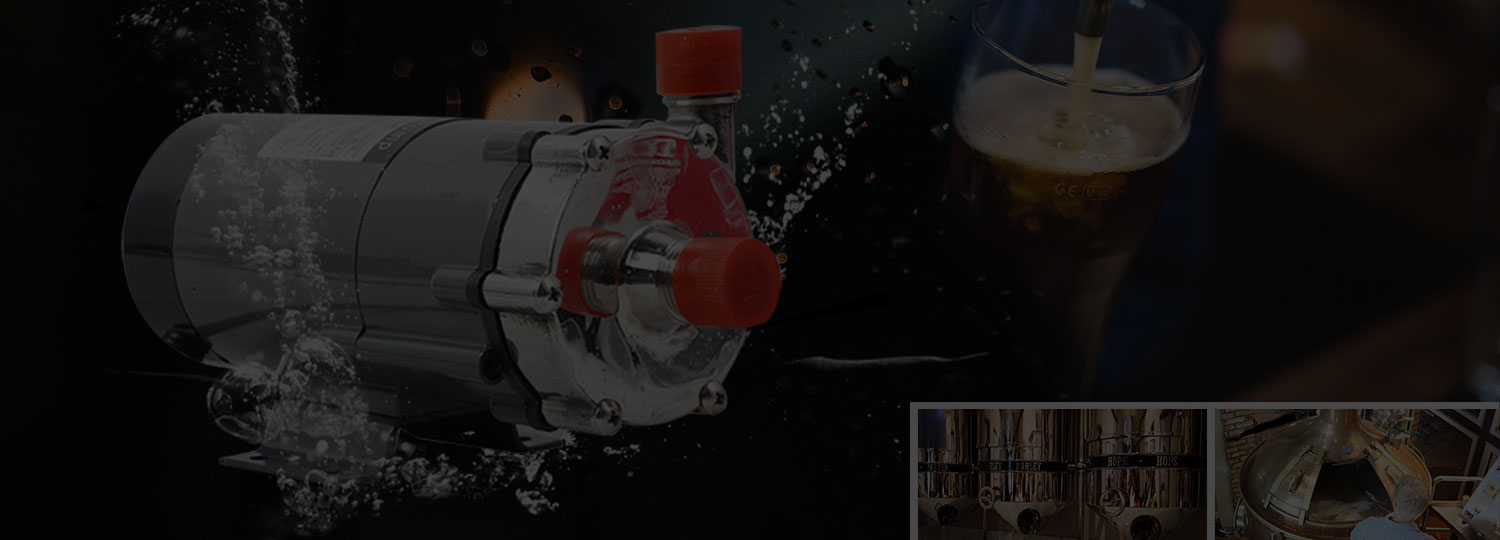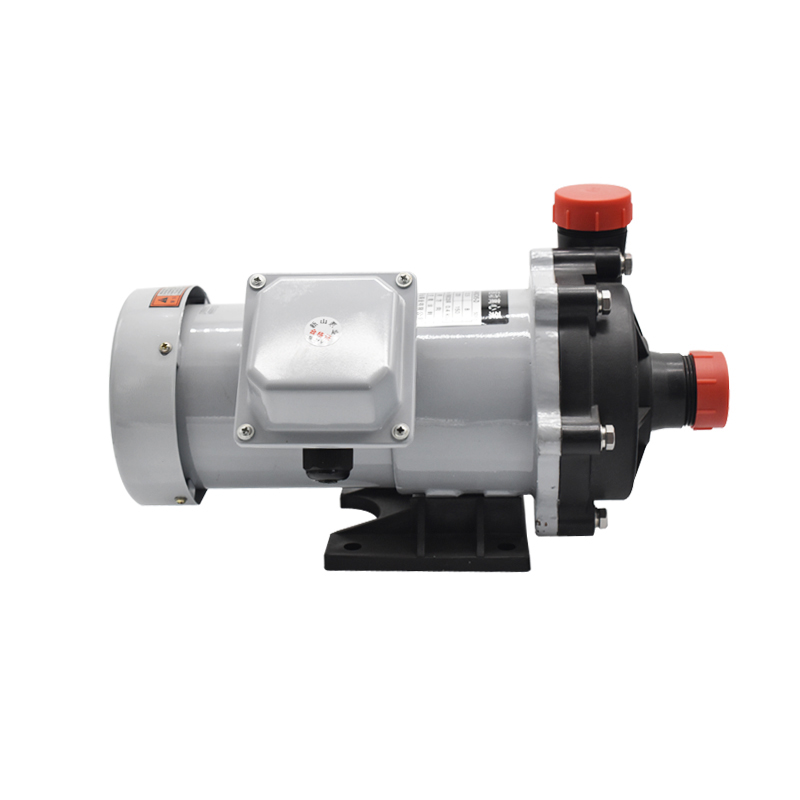Anti-corrosion magnetic pumps- how they work and their benefits?
Anti-corrosion magnetic pump, also known as anti-corrosion magnetic drive pump, works mainly in the following elements.
When the motor drives the outer magnetic rotor to rotate, the magnetic field penetrates the isolation sleeve and drives the inner magnetic rotor connected with the impeller to rotate synchronously to realize the contactless synchronous transmission of shaft power. The dynamic sealing structure which is easy to leak is transformed into a static sealing structure with zero leakage.
Magnetic drives are available in synchronous or asynchronous designs. Most anti-corrosion magnetic pumps are of synchronous design. The motor is coupled to the outer magnet through an external coupling, and the impeller is coupled to the inner magnet. A fully sealed isolation sleeve is provided between the outer and inner magnets to separate the inner and outer magnets* so that the inner magnets are in the medium and the motor’s shaft directly drives the impeller to synchronous rotation through the suction of the magnetic poles between the magnets. Asynchronous design magnetic drive, also known as torque ring magnetic drive. The torque ring of squirrel cage structure is used to replace the internal magnet, and the torque ring rotates at a slightly lower speed under the attraction of the external magnet. Since there is no internal magnet, it is used at a higher temperature than the synchronous drive magnetic drive.
Anti-corrosion magnetic pump mainly has the following advantages.
1 、 Because the drive shaft does not need to penetrate into the pump casing, but use the magnetic field through the magnetic field and isolation sleeve thin wall drive torque to drive the inner magnetic rotor, so fundamentally eliminate the shaft seal leakage channel, to achieve complete sealing.
2、 There is overload protection when transmitting power.
3、 The magnetic material and magnetic circuit design have high requirements, but the rest of the technical requirements are not high.
4、 Small maintenance and overhaul workload.
Table of Contents
What are anti-corrosion magnetic pumps?
What kind of pump type is the corrosion resistant chemical pump, how is it classified, and what is its working principle? The following by CLEY TECH pump valve technical department to sort out and share this knowledge with you.
The Corrosion resistant chemical magnetic pumps are suitable for pumping, circulating and discharging of all chemical solutions containing acid and alkali corrosive ingredients, sewage, etc. They are widely used in electroplating, electronics, chemical, leather, dyeing and finishing wastewater, waste gas and other industries. Corrosion resistant chemical pumps use coupling connection between pump head and motor, and their high-power models are popular for users who pursue large flow.
At present, the main series of corrosion resistant chemical pumps produced in China include FB type corrosion resistant chemical pumps, FFB, AFB stainless steel corrosion resistant chemical pumps, IH type stainless steel chemical pumps, IHF type fluorine plastic chemical pumps, FSB type fluorine plastic chemical pumps, CQB chemical magnetic pumps, IMD chemical magnetic pumps, FZB chemical self-priming pumps and so on. As a professional chemical pump manufacturer in China, Jiangsu Liquid Spring Pump & Valve Manufacturing Co. These chemical pumps are widely used in chemical, metallurgical, pharmaceutical, chemical foil and other industries, and play an important role in the industrial application process.

What are the different types of anti-corrosion magnetic pumps?
Corrosion resistant chemical magnetic pumps are classified according to the working principle.
1. Volumetric pump
By the movement of the working parts caused by the working volume periodically increase and decrease and suction and discharge of liquid, and by the working parts of the extrusion and directly make the pressure of the liquid can increase.
According to the different ways of movement of moving parts are divided into: reciprocating pumps and rotary pumps two types.
According to the different structures of moving parts are divided into: piston pumps, piston pumps, gear pumps, screw pumps, vane pumps and water ring pumps.
- Impeller pump
The impeller pump is driven by the impeller to rotate the liquid at high speed and the mechanical energy is transferred to the transported liquid.
According to the pump impeller and the different structural characteristics of the flow channel can be divided into: (1) centrifugal pump; (2) axial flow pump; (3) mixed flow pump; (4) vortex pump
- Jet pump
Jet pump is to rely on the working fluid generated by the high-speed jet diversion fluid, and then through the momentum exchange and the energy of the piloted fluid increased.
According to the driving pump engine to be divided:
(1) electric pump;
(2) steam turbine pump;
(3) diesel engine pump
History
How have anti-corrosion magnetic pumps evolved?
The magnetic coupling drive pump (magnetic drive pump as said ) started to be developed in 1947 by Geoffrey Howard of the British HMD company. A few years later FranzKlaus of West Germany also successively developed and completed. The first two companies to use magnetic drive pumps were Imperial Chemical Industries in the UK and Bayer Chemicals in Germany. The beginning of the development of magnetic pump is to better protect the safety and health of industrial site personnel engaged in chemical, nuclear power, defense, etc.
Since the mid 1970s, magnetic pump technology has been greatly improved by the development of a new generation of permanent magnets and silicon carbide bearings, such as rare earth cobalt (1978) and the powerful NDEB (1983). According to foreign tests and literature, the flow rate of magnetic drive pump can reach 1150m3/h, head can reach 500m, medium temperature range -120c ~ 450c, viscosity limit of 100 ~ 200cp, the content of abrasive solid particles in the medium can reach 1.5%, solid particle size up to 100m; after taking special measures, the pump can transport slurry containing 20% insoluble solids, solid Magnetic drive pump is also adapted to the mechanical seal is difficult to perform the high vacuum operating conditions. These technical breakthroughs and other improvements have led to a spectacular increase in the reliability and economy of magnetic drive pumps. The study of the effectiveness and repairability of magnetic drive pumps and mechanical seal pumps shows that the failure rate and failure rate of sealed pumps is significantly higher than that of magnetic drive pumps.
For example, the average life of a mechanical seal in a 400C hydrothermal pump is 6 months, while a magnetic drive pump can operate for years, with the only maintenance required being normal lubrication of the external bearings of the pump and motor. Many experiences gained in the chemical industry have led to the conclusion that magnetically driven pumps have developed into an economical solution for many process plants. Therefore, the use of magnetic drive pumps has increased not only because of a reliable environmental factors, but also because of the economic factors that significantly reduce the operating and maintenance costs.
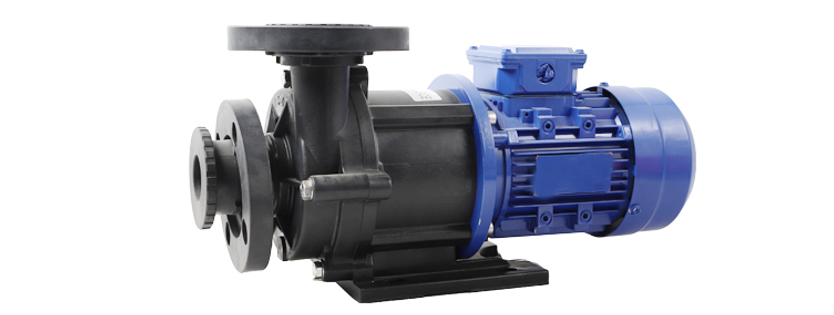
What are some milestones in the development of anti-corrosion magnetic pumps?
As a big branch of the pump industry, magnetic pump is a new performance product, experienced a short development stage, is now widely used in the country, the role of magnetic pump is visible in the smallest part of our daily life, its development seems to be as good as ever, but also faces a series of troubles.
In foreign countries, magnetic pumps have appeared as early as the 1930s and 1940s, since then began a continuous development, in the market all the way through, so far, there are already many well-known international large enterprises, the scope of its application is also broadening, with globalization and rapid economic development, the use of magnetic pumps in the world has a rapid growth, while in the country, due to the level of development of the problem, its development Relatively poorer than developed countries, and higher than other countries of the same level.
20 actual late seventies, China’s magnetic pump has begun to get development, after with the increasing amount of imports and gradually began to embark on the road to prosperity, to now, China’s production level, manufacturing technology has been a great development, to meet the basic needs of the country, but also gradually and international standards, production levels and technical force even reached the international level, Shanghai Hongdong pump industry is a good example .
As a mainstay in the development of China’s magnetic pump, our company has been adhering to the road of standardized development, in-depth study of the public demand, and for these needs to make different pump type, adhere to the quality, adhere to the standard development of enterprises, and therefore the domestic market for sure, looking at the development of China’s magnetic pump market, can be like this to eliminate “run, bubble, drip, leak “The number of enterprises, not many.
It can be seen that the development of China’s magnetic pump has reached a whole new stage, to break through the limits of development, to seek a higher level of progress, the rise of the Internet in the future, will set off some waves, bring another opportunity for development, but also bring the development of the dilemma, only able to respond to the development of the times, to ride the wave of the enterprise, in order to really occupy a place in the ever-changing market. And the development of China’s economy and urban construction, will also push the demand for magnetic pumps to a higher point.
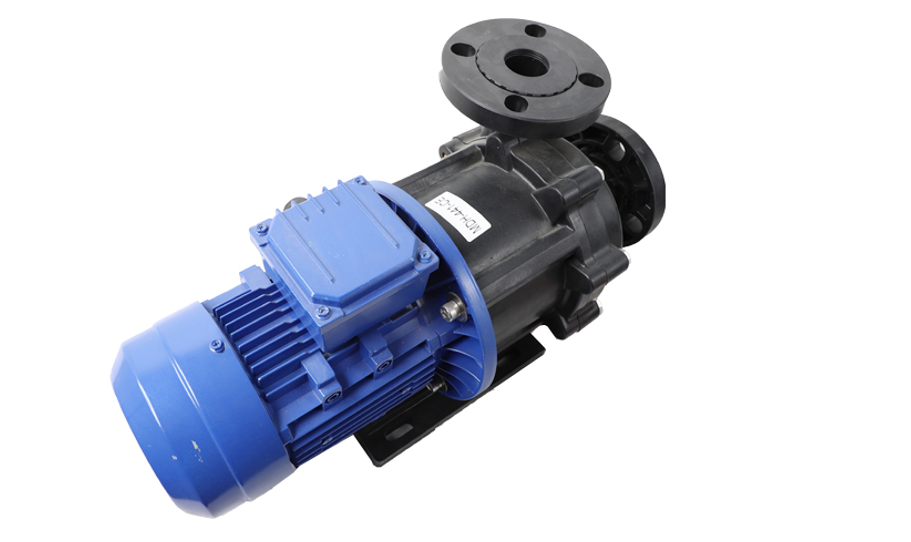
Working principle
How do anti-corrosion magnetic pumps work?
Corrosion resistant chemical pump working principle:
Corrosion resistant chemical pump before work, the pump body and feed tube must be tank full of liquid to form a vacuum state, when the impeller is rotating rapidly, the vanes prompt the liquid to rotate at high speed, the liquid flies away from the impeller under the action of centrifugal force, the water inside the pump is thrown out, the central part of the impeller forms a vacuum area. The liquid material is pressed into the feed pipe through the pipe network under the action of atmospheric pressure. In this way, the cycle does not stop, so that continuous conveying can be realized.
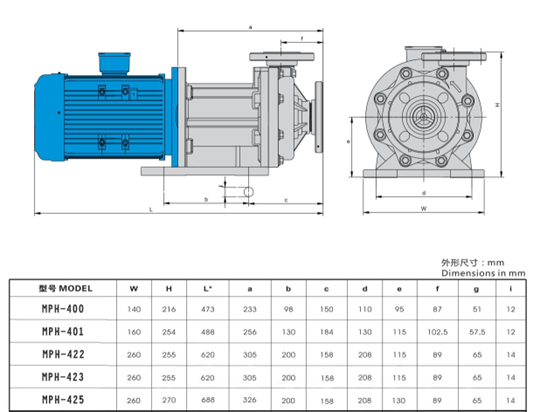
What are the main components of an anti-corrosion magnetic pump?
Anti-corrosion magnetic pump is generally composed of impeller, suction chamber, press-out chamber and sealing device, etc. What are the functions of the main components of anti-corrosion magnetic pump?
1.Impeller
The impeller of anti-corrosion magnetic pump is one of the main parts of the pump. The impeller is driven by the prime mover to rotate and drive the fluid for centrifugal flow, so that the fluid can obtain energy. The role of the impeller is to transfer the mechanical energy of the prime mover to the liquid, so that the liquid can obtain high pressure and high speed energy. The good or bad mechanical properties of the impeller affect the efficiency of the pump. Impeller consists of front cover plate, vane, back cover plate and hub.
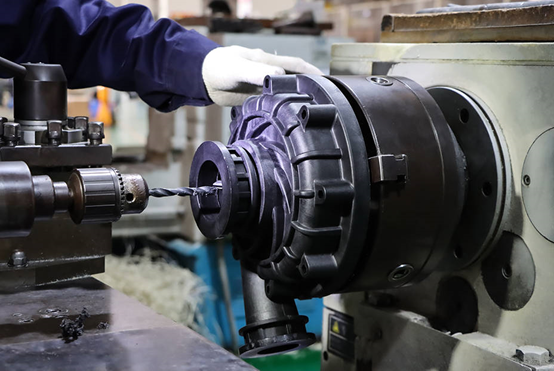
Take you to understand the function of the main components of these anti-corrosion magnetic pumps:
①Closed impeller
It has both front cover and back cover. Closed impeller has high efficiency, but it requires cleaner media to be conveyed.
②Semi-open impeller
There is no front cover plate. This impeller is suitable for conveying liquid containing impurities.
③Open impeller
It has only the blade and the shaft. This impeller is suitable for conveying liquids with large particles of impurities, but the efficiency is low, and it is not used in general.
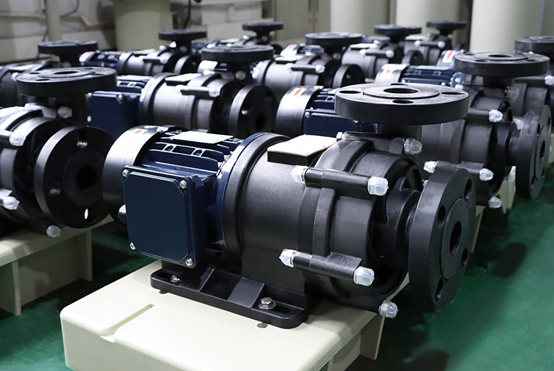
- Press-out chamber
The role of anti-corrosion magnetic pump pressure chamber is to get energy from the impeller of the high-speed liquid gathered, led to the secondary impeller inlet or led to the pressure outlet, while part of the kinetic energy of the liquid into pressure energy.
Because of the large flow rate of liquid in the pressure chamber, the flow of liquid in the process will produce large resistance losses, so a good design of the pressure chamber, should meet the following requirements:
① Minimize losses;
② Reduce the flow rate to achieve partial conversion of kinetic energy into pressure energy.
- Sealing device
There are certain gaps between rotating parts and stationary parts such as impeller and shaft of anti-corrosion magnetic pump, such as the gap between impeller and pump casing, the gap between shaft and pump casing, etc.. In order to reduce or prevent the leakage of liquid from these gaps, sealing devices must be set.
The sealing device is divided into sealing ring and shaft end seal.
①sealing ring
As the impeller outlet pressure is high, the inlet pressure is low, the fluid flowing from the impeller will be part of the return to the impeller inlet. To prevent high-pressure fluid leakage to the suction port through the gap between the impeller inlet and the pump casing, so the seal ring is installed between the outer ring of the impeller inlet and the pump casing.
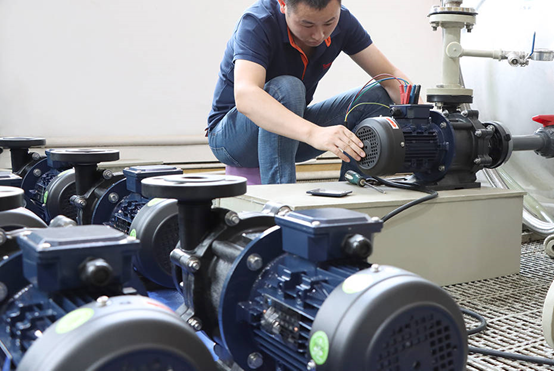
②Shaft end seal
The pump shaft extends outward through the pump body, and a gap exists between the rotating parts and the stationary parts. Depending on the relative size of the pressure inside the pump and the outside pressure, it determines whether the fluid flows out of the pump body. If the pressure inside the pump is greater than the outside pressure, fluid leaks outward from the gap, and conversely, air flows through the gap into the pump. In order to reduce leakage, shaft end seals are installed at the gap. Shaft-end sealing devices are packing seal, mechanical seal, floating ring seal, etc.
Applications
What are some common applications for anti-corrosion magnetic pumps?
Specific application areas include.
- Chemical industry: production and transportation of hydrochloric acid and hypochlorous acid, production of fluoride and all kinds of chemical fertilizers, gas absorption reaction liquid circulation, refining of sulfuric acid, recovery and regeneration of waste acid liquid, unloading of strong acid transport vehicles, etc.
- Pharmaceutical production industry: the production of pesticides, pharmaceuticals, water treatment and other chemical agents.
- Metal manufacturing industry: alumina film treatment equipment, wire drawing, degreasing and pickling of steel rolling, degreasing and pickling before vehicle painting, production and manufacture of titanium chloride, etc.
- Electroplating industry: it is suitable for acid and alkali liquid circulation of various chemical liquid filters.
- Mineral industry: conveyance of electrolyte in metal smelting, washing treatment of waste liquid.
- Medical equipment industry: applicable to various medical equipment washing machines.
- Water treatment industry: conveying and desalination treatment of seawater.
8. Pollution control industry: treatment of various types of sewage, and exhaust gas absorption equipment.
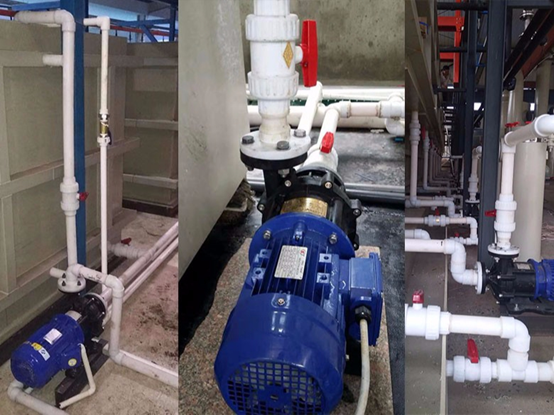
Advantages of magnetic pump
1, because the drive shaft does not need to penetrate into the pump casing, but use the magnetic field through the air gap and isolation sleeve thin wall transmission torque, drive the inner rotor, so fundamentally eliminate the shaft seal leakage channel, to achieve a complete seal.
2、The magnetic pump has overload protection when transmitting power.
3、In addition to the magnetic material and magnetic circuit design having high requirements, the rest of the part technical requirements are not high.
4、The maintenance and overhaul workload of the magnetic pump is small
Disadvantages of magnetic pump
1、The efficiency of the magnetic pump is lower than that of the traditional centrifugal pump.
2、the material and manufacturing requirements of the isolation sleeve to prevent single-sided leakage are high. Such as improper material selection or poor manufacturing quality, the isolation sleeve can not withstand the friction of the inner and outer magnets are easy to wear, and once broken, the transported media will spill.
3、 magnetic pump because of the material and magnetic transmission restrictions, so the domestic general only for the transport of 100 ℃, 1.6Mpa below the medium.
4、The wear resistance of the magnetic pumps is not high, so the magnetic pump is generally used for conveying media that do not contain solid particles.
5、magnetic pump coupling alignment requirements are high, improper alignment will lead to damage to the bearing at the inlet and wear of the anti-single-sided leakage isolation sleeve.
Conclusion
Corrosion-resistant chemical pump has the advantages of stable and reliable performance, good sealing performance, beautiful shape, easy to use and maintenance.
Corrosion resistant chemical pump is a pump type that is extremely widely used in the process of chemical industry. CLEY pump industry is specialized in the research and development and manufacturing of corrosion resistant chemical pumps for many years, and has been producing and supplying in the corrosion resistant chemical pump industry for many years. Because of the special characteristics of the pump, not only the anti-corrosion performance of the pump should be considered, but also the efficiency of the pump transmission, CLEY pump industry recommends that users in the purchase of chemical pumps before, not only to fully understand the working environment and circulation medium, but also the product selection to make the right judgment, otherwise there may be a product life is not long, or to the production process related to the trouble!

